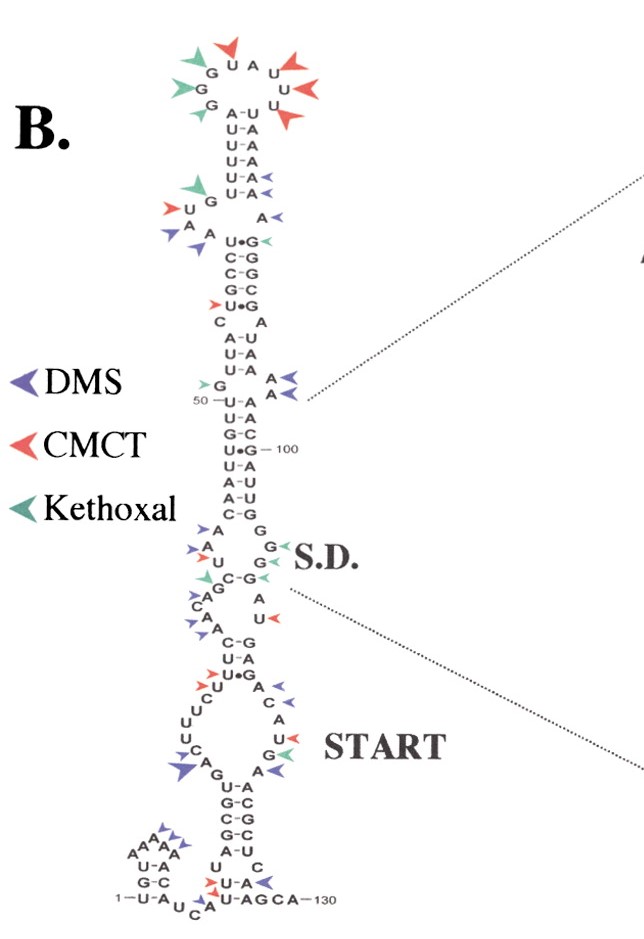Difference between revisions of "Part:BBa K4345010"
| (3 intermediate revisions by 2 users not shown) | |||
| Line 3: | Line 3: | ||
<partinfo>BBa_K4345010 short</partinfo> | <partinfo>BBa_K4345010 short</partinfo> | ||
| − | RNA thermometer used for post-transcriptional regulation based on a temperature-dependent system, based on a RNA thermometer from Listeria monocytogenes. It is maximally expressed at 37ºC and almost not detectable at 30ºC. | + | RNA thermometer used for post-transcriptional regulation based on a temperature-dependent system, based on a RNA thermometer from ''Listeria monocytogenes''. It is maximally expressed at 37ºC and almost not detectable at 30ºC. It operates as a reversible molecular zipper that controls the availability of the RBS in its structure. When the temperature increases, the thermometer unzips and the RBS can be detected by the ribosome thus allowing translation of downstream mRNA. When the temperature is below a certain range, the RBS gets trapped (Johansson et al., 2002). |
| − | |||
| − | |||
<!-- --> | <!-- --> | ||
| − | + | ===Sequence and Features=== | |
<partinfo>BBa_K4345010 SequenceAndFeatures</partinfo> | <partinfo>BBa_K4345010 SequenceAndFeatures</partinfo> | ||
| − | + | ||
| − | === | + | |
| − | + | ===Usage and Biology=== | |
| − | + | The figure below shows the secondary structure of the RNA thermometer. | |
| + | |||
| + | [[Image:PrfA Johansson et al 2002.jpeg|300px]] | ||
| + | |||
| + | Image obtained from Johansson et al., 2002 | ||
| + | |||
| + | ===References=== | ||
| + | Johansson, J., Mandin, P., Renzoni, A., Chiaruttini, C., Springer, M., & Cossart, P. (2002, September). An RNA Thermosensor Controls Expression of Virulence Genes in Listeria monocytogenes. Cell, 110(5), 551–561. https://doi.org/10.1016/s0092-8674(02)00905-4 | ||
Latest revision as of 12:58, 8 October 2022
RNA thermometer prfA
RNA thermometer used for post-transcriptional regulation based on a temperature-dependent system, based on a RNA thermometer from Listeria monocytogenes. It is maximally expressed at 37ºC and almost not detectable at 30ºC. It operates as a reversible molecular zipper that controls the availability of the RBS in its structure. When the temperature increases, the thermometer unzips and the RBS can be detected by the ribosome thus allowing translation of downstream mRNA. When the temperature is below a certain range, the RBS gets trapped (Johansson et al., 2002).
Sequence and Features
- 10COMPATIBLE WITH RFC[10]
- 12COMPATIBLE WITH RFC[12]
- 21COMPATIBLE WITH RFC[21]
- 23COMPATIBLE WITH RFC[23]
- 25COMPATIBLE WITH RFC[25]
- 1000COMPATIBLE WITH RFC[1000]
Usage and Biology
The figure below shows the secondary structure of the RNA thermometer.
Image obtained from Johansson et al., 2002
References
Johansson, J., Mandin, P., Renzoni, A., Chiaruttini, C., Springer, M., & Cossart, P. (2002, September). An RNA Thermosensor Controls Expression of Virulence Genes in Listeria monocytogenes. Cell, 110(5), 551–561. https://doi.org/10.1016/s0092-8674(02)00905-4

